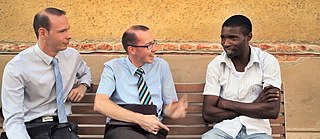Asylum and refugees
Refugees Welcome – german documentary films

Especially the media often make refugees out to be a threat to the status quo. Several politically committed documentary films, however, take a more nuanced look at those people for whom the flight into the unknown is often the only alternative to marginalization, violence or death in their own homelands.
A brief newspaper article begins Philipp Scheffner’s documentary film Revision (2012). In 1992 two Romanian men were shot by German hunters in a grain field in Mecklenburg-Western Pomerania, near the German-Polish border. In the twilight, the perpetrators explained, they took the Romanians for wild boar; after a short investigation, both were acquitted. The death of the men remains unpunished; the case ended up on the shelf.
Twenty years later, Scheffner subjected the case to a thorough investigation. In the course of his reconstruction, he got in touch with the families and friends of the victims. To his surprise, he discovered that no one had ever taken the trouble to inform them of the court case, let alone to question them as witnesses. He developed an unusual method that enabled the families of the dead men to have their say. They listened to their own statements before the camera a second time and so could gather an idea of their medial effect. The film’s viewers see not bereaved people dissolving into tears, but rather confident interlocutors who are very well aware of their media impact. Thus Revision provides uncommon insights into the conventions of the documentary approach.
Deconstruction of stereotypes
They are seeking freedom, often have idealized ideas of their new home and land in a refugee camp: if you apply for asylum in Germany, you must normally live in a refugee centre for months, sometimes years, and may not move about freely within the country. In recent years political and social protest has increasingly arisen against these conditions. The filmmakers Antje Kruska and Judith Keil have also taken up this issue. In Land in Sicht (i.e., Land in Sight) (2013), they portray three refugees put on involuntary hold until the clarification of their status as refugees and the question whether they will receive a work permit.
Abdul from Yemen, the Cameroonian Brian and the Iranian Farid came to their new homeland with very different notions of life in Germany. To start with, all three found themselves in a refugee centre in the small Brandenburg town of Bad Belzig. They were faced with the arbitrariness of the public authorities, but also met people who opened doors for them to everyday life in Germany. These encounters are not without intercultural misunderstandings, sometimes comic, sometimes tragic – for example, when they try to understand the official language of the German Federal Employment Agency. Just such moments make plain how powerful clichés and prejudice are – on both sides. And that nevertheless there is a chance to surmount them. For their empathetic and nuanced cinematic portrait, Kruska and Keil received the 2013 Goethe-Institut Documentary Film Award.
Unintentional comedy of prescribed integration
In her film Werden Sie Deutscher (i.e., Become a German) (2013), Britt Beyer accompanied participants in an integration course in Berlin-Neukölln for ten months – in the classroom and everyday life. German immigration law can oblige foreigners who want to live permanently in Germany to take such courses. The curriculum includes not only language acquisition but also a much more complex goal: integration into German society. Werden Sie Deutscher remains on an equal footing with its main characters; the camera registers moods, irritations and the smallest gestures. The skilful montage reveals the absurdity of trying to teach how to become a German in a crash course. Beyer does without explanatory commentary. Thus the viewer can and must make the connections for himself. This “mature” approach to presentation presumes to impose no judgement and deliberately allows the viewer room for the appraisal of what is seen.Absurdity of the situation works on the viewer
In Can’t be Silent (2013), Julia Oelkers has also decided against a commentary. She documents the tour of the band Strom & Wasser feat. The Refugees, which consists of German musicians and musicians who have fled to Germany from all around the world. The film shows clearly how restricted a refugee’s range of movement is – both physically and emotionally. When he stands on stage, he is an acclaimed star, but afterwards there remains only the way back into the fenced camp and the fear of deportation. Oelkers lets this absurdity work on the viewer. She knows that whoever has once heard Nuri, Revelino and the others will immediately see the issue of “asylum” with different eyes.